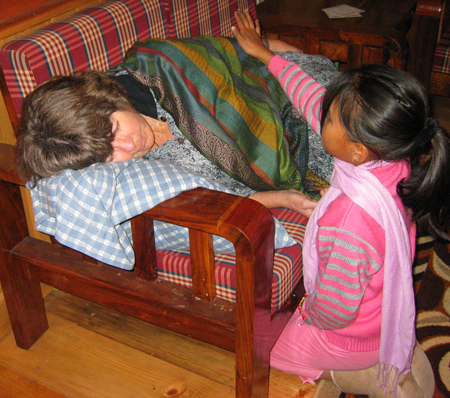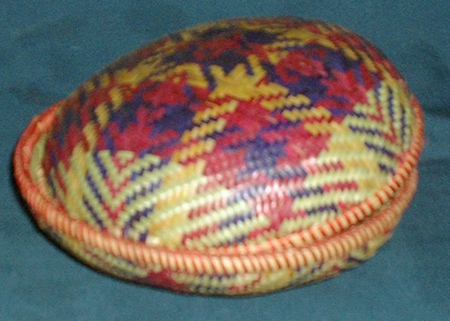MONTESSORI PROJECT
|
Click on these dates/links, to see Susan's emails and pictures Bhutan 2008 — Main page for 2008 trip |
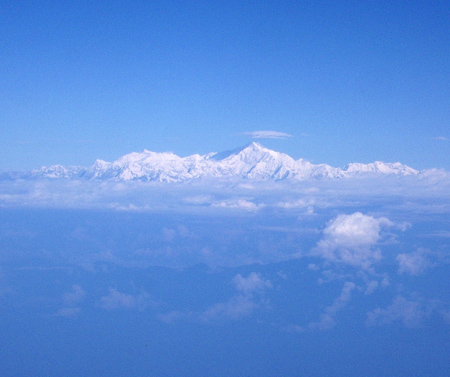 |
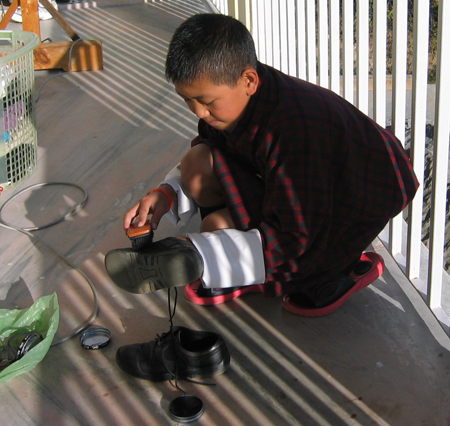 |
Mt. Everest or सगरमाथा or ོ་མོ་གླང་མ |
This is Kinley, the son of Dendy and Chencho. Without toys to distract them from real life, children naturally carry out all of the daily work of the family they see going on around them. |
GOOD MORNING ALL, The Montessori children in Connecticut seem to be very hungry for news to I am writing again today to everyone. I forgot to mention that we had an incredible view of Mt. Everest, the tallest peak in the world, on the flight into Paro. I have seen this mountain from Nepal and again from Tibet (China) but this view was the most beautiful. In Nepal Mt. Everest is called "Sagarmatha", सगरमाथा , which means "Head of the Sky", and in Tibetan it is called Chomolungma or Zhumulangma, ,ོ་མོ་གླང་མ, At the airport we met Miss Thailand, who had come to judge the Miss Bhutan contest. I had noticed someone asking for the autograph of the person in front of us in the "diplomat" line going through customs at the airport and so asked her if she was a famous person. She was delightful and told us all about the contests. Her mother was with her and they both looked about 18 years old. |
Almost everyone at the airport had come to trek, or walk the mountain trails. I had an interesting chat with one man on the plane who, with his wife, had trekked in Nepal. She had been so depressed by the poverty she saw there that she was worried about encountering the same situation in Bhutan. I assured him that, although Nepal and Bhutan had opened their borders at the same time (1960's in reaction to China's invasion of Tibet, realizing that they needed contact with the outside world to survive), Bhutan had had wise advisors and is in much better shape. Even medical is free for everyone. I was a little concerned however because both he and his wife were wearing shorts, and in Bhutan, as in most Asian countries, it is really embarrassing to see a person's legs, or even their shoulders. I was worried that they would offend, but didn't want to embarrass them by saying anything. Then, I overheard the wife say "I think I will change into long pants in the airport." Perhaps she had noticed that no one else was wearing shorts. So then I was able to say "Yes,good idea. That would be more respectful." and she was very happy to hear that her instinct was correct. |
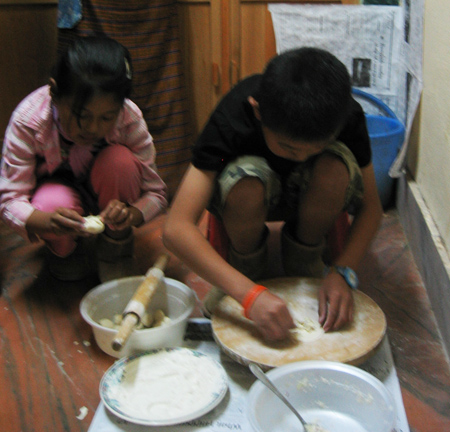 |
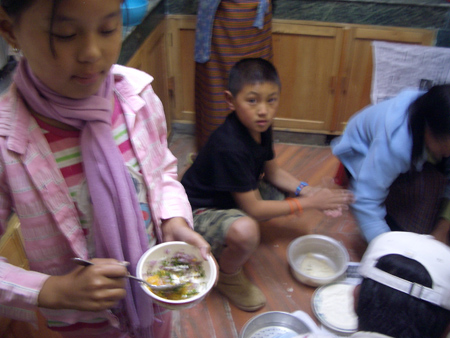 |
Making momos (cheese and veggie steamed dumplings). Omo and Kinley shaping them, having learned how from their father over the years, in a variety of lovely shapes. |
Even though there are kitchen counters, the momos are made on the floor. Here Kinley is rolling the dough balls, Dendy rolling them out, Omo making the sauce that accompanies them, and dad shaping them. |
It is very interesting to explore the practical life here. For example, when given a gift, it is not polite to make much of it or to open it in front of the giver. And when one receives a gift it is often shared or given away. I noticed last trip. I had brought a very special hair ornament, hand-made by Native Americans, to Dendy as a gift. The next day Omo was wearing it to school! BATHING: Remember I said that no running water was found in the traditional houses, to keep the pounded mud walls from being damaged? Well in this cement house there is inside running water and a bathtub and shower, but in the traditional homes there is not. Instead there is a sunken or raised wooden tub in the yard or the bath house shed and a hose running into it to fill it (or buckets if near a river, and what beautiful and clean rivers they are!). Nearby there is a fire area and large rocks. |
The fire is lit, the rocks heated by the fire, the tub filled with water, then the rocks placed in the tub to heat the water for the bath. More recently electricity is used to heat the water. Just like the little heating elements or coils I have used to heat water in a cup in India to prepare tea or make water safer to drink, a larger element is submerged in the small metal tub just outside the house. Children are kept away from this stage of bathing preparation so they do not get electrocuted. When the water is ready they either sit in the little tub to bathe if they are small enough, or the parent used containers to swoop the water over them. In tourist hotels one is sometimes offered a "hot rock bath" as a cultural experience, but usually the tub is filled from the tap with hot water and the hot rocks put in just for show. I hope we get to see the real process! |
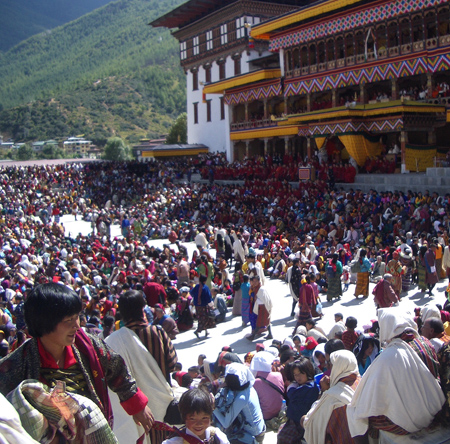 |
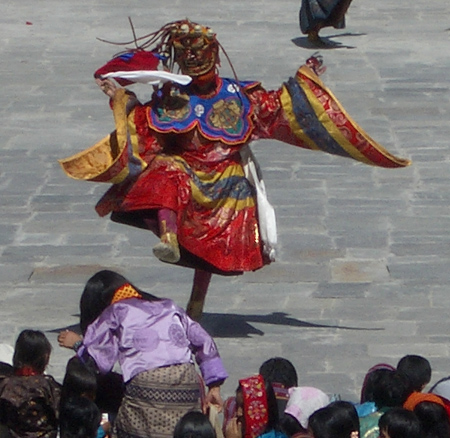 |
People gathering to see the dancing at the Thimphu Dzong tsechu. |
A highlight for me was to see the Buddhist monks dancing in traditional masks and costumes. |
Yesterday we drove from Paro to the capital city, Thimphu, to visit Dendy's family and to attend a Tsechu. Tsechus are very special ceremonies carried out just a few times a year and we were very lucky to be here to experience one. Tsechus give the people an opportunity to dress in their most beautiful national costumes which is only done once a year for many. Although it is considered a Buddhist ceremony during which one becomes a better person, it is great fun and there are clowns in the audience and a lot of food and fun. We saw people carrying their food in the newer plastic containers but also in the flattish round baskets used for many years. A pair of flattish baskets fitting together is called a bangchung (see below). Popcorn, popped rice, and shopped raw corn is often served in these baskets before a meal, everyone gathering on the floor of the home, eating with their hands and sipping tea. |
LANGUAGE: Here are some of the words I have learned in Dzongkha, the language of Bhutan: |
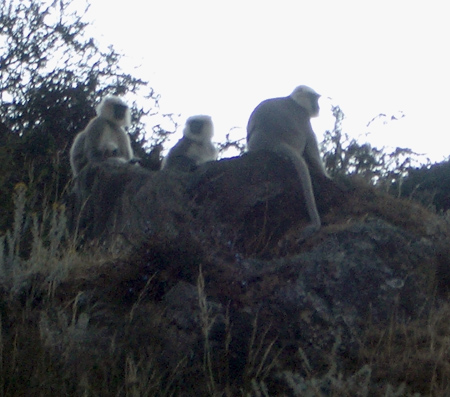 |
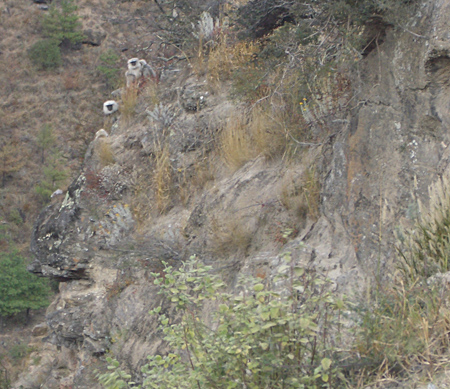 |
Parent and other adults of this Langur monkey group |
Baby Langurs trying to summon courage to cross the road to be with the adults! |
By the end of my last visit, I had become quite close to Omo and Kinley and their parents. Omo and Kinley are delightful children and as polite and kind and helpful as their parents. It was like meeting family when I returned this year, and the children hug me many times a day and check to see that I am happy, come to meals, rested, warm. To close this email I am going to tell you one more Dzongkha work relate to all this love and hugging. The word is monke. I don't think we have a word for it in English but it refers to the soft skin below the chin of a 65-year old woman like myself! Omo just loves to fondle mine, she likes the way it wiggles she says. Yikes! It is great to be in a place where old people are revered and do not try to look younger than they are. |
Oh, I forgot. Yesterday on the way from the ceremony in Thimphu, we saw a large family of monkeys. They were very special kind of monkey coming down to the warmer climate from the mountains for the winter. They are called Hanuman or Gray Langurs! They are so elegant and large with long fur and very large long tails. They live in trees, and so could leap and climb the cliffs on either side of the road with miraculous ease. There were several adults on the south, the high side of the road. Suddenly we saw what was keeping them near the road: there were 4 tiny baby langaurs on the other, the down cliff side of the road trying to cross the road to join the adults. Every time they bravely climbed, slowly and silently, to the edge of the road a car or truck would come along and they would scamper back down the cliff for safety. LOVE, |
|
|
Omo covering Susan with her shawl to rest after a long day (Gunilla's photo) |
bangchung or pair of baskets that fit together to transport or serve food. |
Return to the Bhutan Montessori Project home page — Bhutan, 2006 Return to Michael Olaf Children's Projects — Projects |
|
